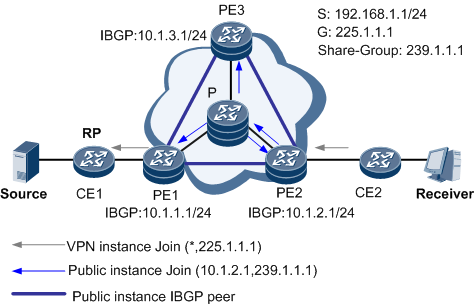Switch-MDT Switchover
Background
According to the process of establishing a Share-multicast distribution tree (Share-MDT) described in the previous section, you can find that the VPN instance bound to PE3 has no receivers but PE3 still receives the VPN multicast data packet of the group (192.168.1.1, 225.1.1.1). This is a defect of the multicast domain (MD) scheme: All the PEs belonging to the same MD can receive multicast data packets regardless of whether they have receivers. This wastes the bandwidth and imposes extra burden on PEs.
In MVPN, an optimized solution, Switch-MDT, is provided so that multicast data can be transmitted on demand. It allows on-demand multicast transmission. Traffic will be switched from the Share-MDT to the Switch-MDT if the rate of multicast traffic on PEs reaches the threshold. Only the PEs that have receivers connected to them will receive multicast data from the Switch-MDT. This reduces the burden on PEs and bandwidth consumption.
Implementation
Figure 1 shows the switch-MDT implementation process based on the assumption that a share-MDT has been successfully established.
On PE1, set 238.1.1.0–238.1.1.255 as the switch-group-pool address range of the switch-MDT and set the data forwarding rate threshold that triggers a switch-MDT switchover.
When the rate of data forwarded by the source connected with CE1 exceeds the configured threshold, PE1 selects a group address (for example, 238.1.1.0) and periodically sends signaling packets to other PEs through the share-MDT to instruct them to switch to the switch-MDT.
If PE2 has a receiver, after receiving the signaling packet, PE2 joins the group 238.1.1.0. Then, a switch-MDT is set up. The switch-MDT setup process is similar to that of a share-MDT. If PE3 has no receivers, after receiving the signaling packet, PE3 does not join the switch-MDT. As a result, only PE2 can receive the VPN multicast data packets of (192.168.1.1, 225.1.1.1). Note that PIM control messages are still transmitted along the share-MDT.
A switch-MDT switchover occurs if the following conditions are met:
The source and group addresses of VPN multicast data packets match the source and group address ranges defined in ACL filtering rules. Otherwise, the packets are still forwarded along the share-MDT.
The forwarding rate of VPN multicast data packets exceeds the switchover threshold for a specified time range.
In some cases, the forwarding rate of VPN multicast data packets fluctuates around the switchover threshold. To prevent multicast data packets from being frequently switched between a share-MDT and a switch-MDT, the system does not immediately perform a switchover after the system detects that the forwarding rate exceeds the switchover threshold. Instead, the system starts a switch-delay timer. During the switch-MDT setup, the share-MDT is still used for multicast data packet forwarding. Therefore, the switch-delay timer helps implement non-stop data forwarding during a switchover from a share-MDT to a switch-MDT. Before the switch-delay timer expires, the system keeps detecting the data forwarding rate. If the rate remains consistently higher than the switchover threshold throughout the timer period, data packets are switched to the switch-MDT. Otherwise, the packets are still forwarded along the share-MDT.
Switchback from the Switch-MDT to the Share-MDT
A PE switches data back from a switch-MDT to a share-MDT if any of the following conditions is met:
The forwarding rate of VPN multicast data packets is lower than the specified threshold throughout the switch-Holddown period.
In some cases, the forwarding rate of VPN multicast data packets fluctuates around the switchover threshold. To prevent the multicast data flow from being frequently switched between a switch-MDT and a share-MDT, the system does not immediately perform a switchover when the system detects that the forwarding rate is lower than the switchover threshold. Instead, the system starts a Holddown timer. Before the Holddown timer expires, the system keeps detecting the data forwarding rate. If the rate remains consistently lower than the switchover threshold throughout the timer period, the data packets are switched back to the share-MDT. Otherwise, the packets are still forwarded along the switch-MDT.
After the switch-group-pool is switched, the switch-group address encapsulated in VPN multicast data is not in the address range of the new switch-group-pool.
After advanced ACL rules that control a switch-MDT switchover change, VPN multicast data packets do not match the new ACL rules.
